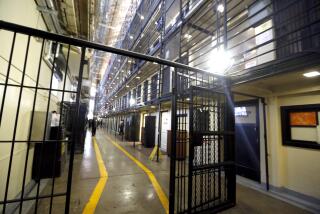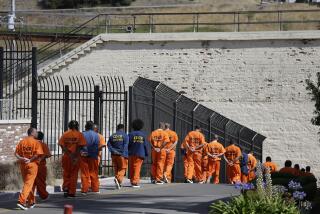San Quentin’s museum is captivating
I called only to find out the museum’s hours, and I wound up getting fashion advice.
“You can’t wear blue, no denim, no jeans,” I’m told. “No lime green shirts. And no orange. Like, the color of an orange jump suit.”
Set straight, sartorially, I pulled up to the gates of San Quentin State Prison, just over the Richmond-San Rafael Bridge in Marin County, not knowing what to expect. Bomb-sniffing dogs? Body-cavity search? Snarling gun-toting guards?
Instead, I was greeted by a guard who kept a smile on his face and his firearm safely holstered. He pointed me to the visitors parking area and then had me flash a photo ID before signing a log book. Under purpose of visit, I scrawled “museum.” He gave it the once-over, nodded, said, “That brown building right over there. Lot to see in there. Enjoy.”
Enjoy? Isn’t that kind of an odd thing to wish someone about to step into a building housing grisly, macabre artifacts and totems from perhaps the most notorious penitentiary this side of Gitmo, this stark, stucco edifice hugging the fog-shrouded bay shore, home to death-row inmates and the former residence of the likes of Charles Manson and Sirhan Sirhan?
Turns out, a visit to the San Quentin Museum is, indeed, quite enjoyable. A bit creepy, yes. Somewhat gruesome, definitely. But, in all, it lifts the veil off the mystique of California’s first prison, opened 162 years ago and looking every day its age, and tells the stories of some of the state’s most notorious bad guys and the people whose job it was to keep them safely behind bars.
There’s a fascinating wing devoted to executions, from hangings to the gas chamber to lethal injections, with models of the implements of death and, occasionally, even the items themselves. Lining the walls are examples of ingeniously crafted inmate weapons, all manner of shivs and clubs, homemade hash pipes and even MacGyvered hypodermic needles. Shelves and shelves of firearms brandished by officials, from a 1937 Browning machine gun retired from the guard tower, to tear-gas weapons and a Thompson machine gun used during the infamous 1971 George Jackson escape. And, yes, there is a wall dedicated to inmates who, over the years, attempted to break out, including a braided bed sheet with a rebar hook on the end one used to scale the walls.
All the memorabilia is fine and all, but what makes the museum special is its curator, Jeff Craemer, who as a kid watched as the old Spanish cells were dismantled, who later covered the courts as a reporter for the Marin Independent-Journal and who, with former associate warden Richard W. Nelson, hatched a plan in 1984 to build a museum on-site. Nearly a decade later, it opened and Craemer, 66, has spent a good chunk of his retirement doggedly accumulating San Quentin ephemera to bolster the already-expansive collection.
He mans the front desk each Tuesday and Thursday (the only days the museum is open), happy to be spending his morning at the prison, waiting to regale visitors with stories from the old days. When I walked in, he was right in the middle of telling a story about sitting “in that very seat” on a June day in 2013 when ambulances sped past and the facility was put on lockdown. “Richard Ramirez remember him, the Night Stalker? had died in his cell,” Craemer told the visitors, “caused a big commotion.”
I asked if there was much, you know, action at the prison, whose cell blocks are only a few hundred yards from Craemer’s desk.
“Nah,” he said, “but occasionally I’ll come here and they’ll tell me, ‘You’re not open today. We’re in lockdown.’ ”
Assuming no lockdown is up, Craemer will lead you around the snaking halls, whose walls are lit up with lurid, all-caps headlines about executions and escapes. Being an old newspaperman, he doesn’t bury the lead. He takes you, straight off, to the execution wing.
“We’ve got the rope from the last prisoner hanged here in 1942,” he said. “These two sisters (Dorothy Hogeboom Powers and Marlene O’Neill) came in and told me their father was the executioner and did I want the rope and his cigar box, too. I said, ‘Heck, yeah.’ Here it is.”
Craemer doesn’t give you the chance to read the text about the life and execution of “Rattlesnake” James (a.k.a. Raymond) Lisenba, the last man on the gallows before the gas chamber became San Quentin’s preferred means of extinction. He’s smiling broadly, not even trying to mask his gallows humor.
“Now ‘Rattlesnake,’ he had six wives,” Craemer said. “First wife, poisoned her. The second wife, he turns a rattlesnake loose in the yard, it bites her in the heel. She falls over and drowns in the fish pond. He says, ‘Good thing I had a life insurance policy.’ The third one got injured in a suspicious auto accident, recovering. He put duct tape around her, put her feet in a rattlesnake box to kill her. That didn’t work, so he put her in the bathtub and drowned her. Wonder why he was hanged?”
Next to a grainy mug shot of the steely-eyed Rattlesnake James is the rope used, its braids a bit frayed by time but looking as if it still could do the job. In fact, though, the rope proved to be the wrong length and “Rattlesnake” didn’t die immediately, like other prisoners on the gallows. The medical examiner’s report, blown up to poster size, gives the facts: “Trap sprung: 10:011/2 a.m. Pronounced dead: 10:141/2 a.m. Remarks: ‘Very successful.’ ”
And about that cigar box, mounted next to the rope? It’s full of hand-crafted miniature nooses, with tags marking every hanging the executioner presided over. The box is full.
“Dorothy told me that’s just what her father liked to do,” Craemer said. “But, look, we got some good stories over at the gas chamber (display), too.”
None is better than the saga of Robert Wells, an inmate who helped build the chamber in 1938. San Quentin used Wells because he was 4-foot-11 and could fit in tight places and had mechanical acumen.
“Shortly after (Wells’) parole, he killed his brother, his sister in-law and his friend because they broke up his incestuous relationship with his half-sister,” Craemer said. “So he died in the very same gas chamber he built.”
Craemer barked out a laugh and led me on, stopping at a display case featuring a black eye mask.
“Oooh, now here’s a bad woman, Barbara (Bloody Babs) Graham,” he said. “You ever see the Susan Hayward movie ‘I Want to Live’? She played Graham. Now, Graham had great disdain for the warden (Harley O. Teets) at the time. She verbally told him so, many times. The warden didn’t like her and told her so, calling her the B-word. Come her time (in the gas chamber), she says, ‘I don’t want to have to see you, you SOB. I want a mask.’ This here is the mask.”
On and on it went, San Quentin lore in all its lurid splendor. When I finally left and returned to the gate to sign out, I was greeted by the same guard.
“See, I told you there’s some good stuff in there,” he said. “Come back next time, bring your family.”
(c)2014 The Sacramento Bee (Sacramento, Calif.)
Visit The Sacramento Bee (Sacramento, Calif.) at https://www.sacbee.com
Distributed by MCT Information Services
More to Read
Sign up for The Wild
We’ll help you find the best places to hike, bike and run, as well as the perfect silent spots for meditation and yoga.
You may occasionally receive promotional content from the Los Angeles Times.






